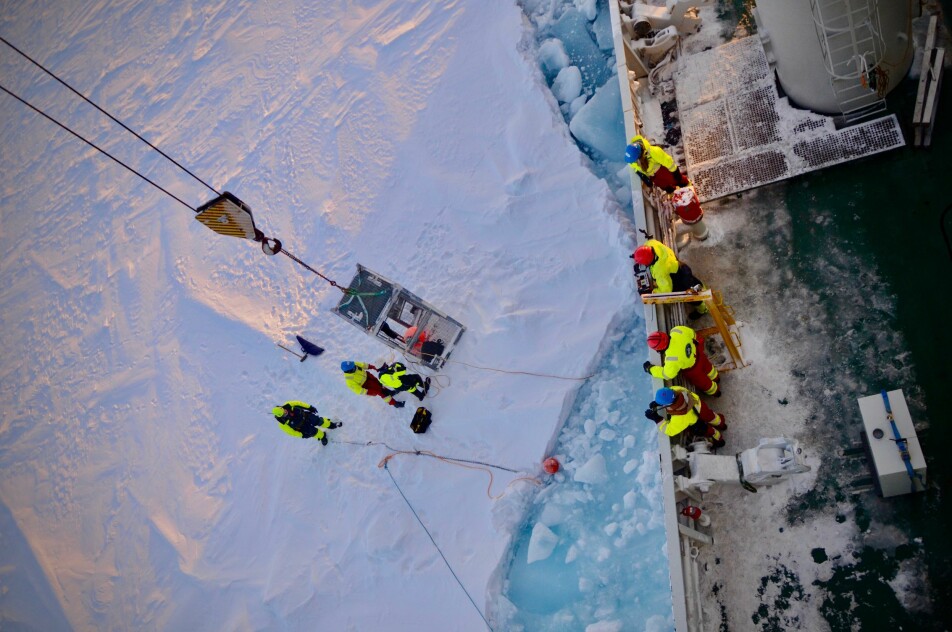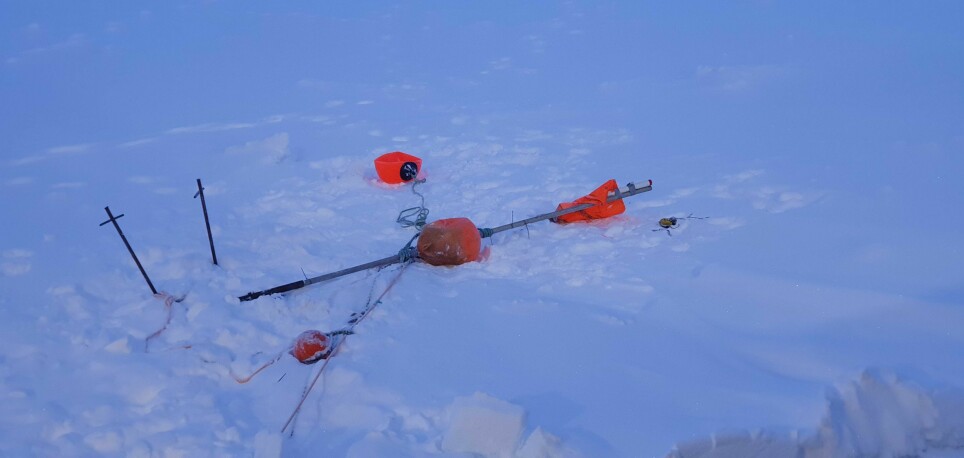Lost and (not always) found:
The ups and downs of sediment trap deployments
Some days you win, some days you lose. Your car keys. A single sock out of your favorite pair. A 200-metre long rope worth hundreds of thousands of kroner in equipment and samples. No? Just us?
“Anything that you put into the sea is considered lost until you recover it” –Andreas Wolden, Assistant fishing master on R/V "Kronprins Håkon"
“Oh, no” –Yasemin and Martí, concerned PhD students
The road from idea conception to manuscript publication is peppered with setbacks. Bad weather prevents us from doing our work, samples are accidentally spilled or mislabeled, devices work slowly in the extreme cold (so do human brains, for that matter). For any unforeseen circumstance and occasional mishap, there is (almost) always a solution, and coming up with ingenious alternatives is a daily task. In field biology, most of these solutions involve duct tape and good intentions.
But what if the ocean claimed your scientific instruments right at the start of your field work? What if an apex predator in its natural habitat decided that it looked very appetizing? How much duct tape does one need to work around that?
First, let us introduce you to the instrument we are talking about: the sediment traps. As the name implies, it is not animals that we catch, but sedimenting material – i.e. sinking particles.
Imagine a 200 meters long rope, hanging vertically in the water, floating with the currents. At different points of this rope (also called “mooring”), we attach simple Plexiglas jars. These are the traps. Material that sinks in the water column ends up in these jars and gets “trapped”, stuck at the bottom. Since particles do not just sink vertically in the water column but follow the currents, we cannot leave the mooring attached to the ship. Instead, we set it out with the traps into the ocean and let it drift on its own for 24 hours (does it not sound risky already?). To ensure its recovery, it is equipped with a large flagpole that floats at the surface and an AIS (a tracking device) so we can follow its motion and collect it. Or so we thought.

Sail away, sail away
Everything started according to plan. We prepared the sediment traps and set them out (no small feat), and patiently waited for the 24 hours to pass until we could retrieve it.
It quickly became apparent, however, that the traps did not follow the currents but moved rather in the wind direction, with the flagpole acting as a sail. We steamed (boat-talk for “drove”) to its location and Yasemin’s keen mooring senses kicked in. The floating flagpole was there, but it seemed so light, bobbing up and down with the waves as if there was nothing underneath to drag it down.
“Highly suspicious behavior if you ask me”, is what the seasoned scientist declared. Tom, from the ever-helpful crew, fastened the mooring to the ship crane and proceeded to lift the pole – and nothing else.
Martí, a shocked bystander, likened it to the experience of dipping a cookie in tea and lifting it after a while, only to find that half of it has broken away and sunk. “Not ready for this lack of closure” was his on-site statement.
What happened? Was the attachment rubbing on the rope with the wave motions, creating a shear-like motion that sawed the rope? Did a Greenland shark use its last, century old teeth to set it free? We will never know, but by then the traps were impossible to recover. The mooring travelled with the currents; the pole went on with the wind, leading us far away from our precious samples.
We are not broken, just bent
Undeterred, we did what PhD students do best: improvise. The next station was approaching, and we were not going to miss it! The mooring we lost was a new, shiny model. We dug out the old, reliable rope that we had kept as a backup and attached it to the newly repaired pole. We had some replacements for our scientific equipment, enough for a reduced sampling effort. Cautiously hopeful, we deployed the sediment traps again. This time, attached to a sea ice floe with heavy metal poles and a thick chain to prevent any breaking. The very image of solidity.

But alas a white, fluffy presence looms over all sea ice work. We all watched, mouths agape and cameras poised, as several polar bears visited the mooring over the course of the day. The scene we found the day after was a testament to the magnitude of these animals: two floatation buoys were ripped to pieces, the flagpole destroyed, the metal poles that we used for securing the chain to the ice were bent like twigs, the AIS on the ice.
Most impressively, the whole mooring was lifted 5 meters onto the ice! If the floe had broken, the weight would have dragged the whole mooring down, and the sediment traps would have been gone forever (again). From then on, our “flagpole” was a bamboo stick and a torn bedsheet. We make do.

Under pressure
And we could go on for a while, to be honest! We will spare you the tale of the time the mooring rope wrapped itself around an ice floe like a neat Christmas present, or of the time the AIS stopped sending its signal and we had to sail around looking with binoculars until a tiny buoy was spotted. Once again we thought it gone, with some polar bear tracks in the vicinity indicating viciously that the buoy was the only thing left from the mooring.
When the ship approached the tiny little buoy, gently removing the ice around it, a large ice floe shifted aside and all of a sudden, the flagged pole with the AIS plopped out from underneath. Understandable that our frozen, cooled and preserved samples that we recovered from all these adventurous deployments turned out invaluable to us.
Each deployment has taught us to expect the unexpected, and we have gotten as flexible as our trusty bamboo stick. We are sailing again in May, we will keep you updated!







